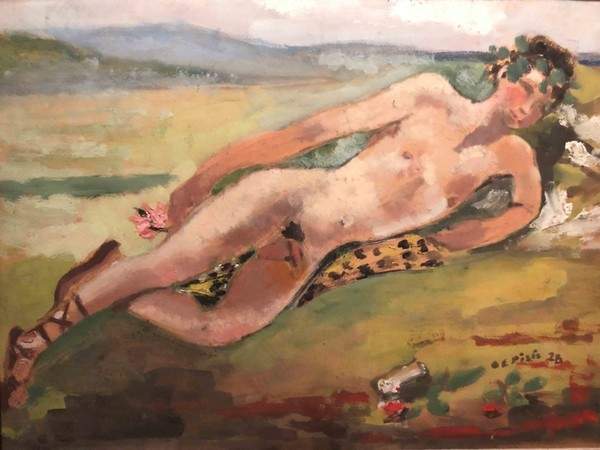FAI - Fondo Ambiente Italiano presents at Villa Necchi Campiglio (Milan) the exhibition La stanza di Filippo de Pisis. Luigi Vittorio Fossati Bellani and his collection, from April 3 to September 15, 2019, curated by Paolo Campiglio and Roberto Dulio.
Rome, 1944: a room filled with furniture and precious objects, with paintings on the walls, almost all by a single painter: the room of Filippo de Pisis. The collection is the effect of a virtuous partnership between painters who paint and write, literati who are passionate about images and music, lovers of the arts and bibliophiles: Luigi Vittorio Fossati Bellani is its animator.
The exhibition brings together for the first time the collection of works, some never exhibited to the public, that Fossati Bellani had collected and set up in his home in Rome. The exhibition is a tribute to the collector and his passion for the work of Filippo de Pisis, which he loved to place alongside the refined canvases of Savinio, Rosai and de Witt.
The idea of the exhibition originates, as an initial cue, from La Tinca (1928), the Depisisian work formerly dicollection Fossati-Bellani then passed into Claudia Gian Ferrarid donated to FAI’s collection of twentieth-century art and kept at Villa Necchi Campiglio. The intent to reconstruct its history has revealed another, significant and compelling one: that of its original collector, who suggested a research path aimed at returning the entire nucleus of works by Filippo de Pisis collected by LuigiVittorio Fossati Bellani. The arrangement, a reflection of the collector’s intentions and taste, led to the creation of a sort of Depisisian Wunderkammer that contains twenty-two paintings made between 1916 and 1943: sixteen by Filippo de Pisis, three by Antonio Antony de Witt, one by Ottone Rosai, and two by Alberto Savinio, all of which were originally displayed in the same room. Among the de Pisis works on display is the famous Bacchino (1928), for years given up for lost, which appears on the exhibition poster, and for the first time the San Sebastiano (1930), the forerunner of a long series of works devoted to the subject. Also prominent is the rare series of paintings created by the painter in the spring of 1935 in London, where he had gone for a stay of a few months, most of which were acquired by Vittorio upon the artist’s return to Paris. Finally, another nucleus of pictorial works concerns canvases created by the artist in his friend’s house in Rome in the early 1940s, the result of an association and complicit friendship.
Thanks to archival materials, to the photographic campaign of documentation of the appartamentorealized in the 1960s, before the dispersion of the collection, and to the careful and patient researchof the dispersed works, it is now possible to appreciate the paintings and drawings in the unfolding of their original location: the impression is that of entering de Pisis’s room for the first time, recreated as a closed volume, in which the blow-ups of the historical images rievocanol original atmosphere. Coming from a wealthy family of textile industrialists, Luigi Vittorio Fossati Bellani, after earning a degree in engineering in Germany, returned to Italy and took part in World War I. At the end of the conflict, he moved to Venice and then to Florence, where he befriended Marino Moretti, a man of letters, poet and writer who probably introduced him to Filippo de Pisis: from the very beginning, the Ferrara artist’s paintings fascinated him and he became a collector of them . Having landed in Rome, he settled in a large apartment inside Palazzo Tittoni on Via Rasella: the street of the partisan attack on the German occupation forces that led to the massacre of the FosseArdeatine (1944). This dramatic event marked the destiny of Luigi Vittorio Fossati Bellani forever: involved in the German roundups, he was released, but after a few days, on April 3, 1944 (the exhibition opens to the public 75 years from this date), tried by the event, he died.
The exhibition is part of the program of in-depth historical and artistic study that FAI has undertaken since 2012: exhibitions with a rigorous scientific approach that aim to study and enhance the activity of painters and sculptors already present at Villa Necchi with one or more works, starting from these to elaborate new paths of in-depth study, always in the wake of the “spirit of the place.” After Alfredo Ravasco, Arturo Martini and Timo Bortolotti the focus is now on Filippo de Pisis, whose six works are on permanent display at the villa: The Tench (1928), The Little Red Shoe (1930), Three Oysters on the Table Top (1932), Still Life with Hare (1942), donated by Claudia Gian Ferrari, a watercolor, Fiori (1947) that belonged to Nedda Necchi, and Portrait of a Young Man (1929) from a private donation.
The exhibition is accompanied by a catalog, published by Skira, edited by Paolo Campiglio and Roberto Dulio, with texts commenting on the collection, and with an interview with Giulia Maria Mozzoni Crespi, founder and honorary president of FAI, niece of Luigi Vittorio Fossati Bellani. For all information you can call +39 02.76340121 or email fainecchi@fondoambiente.it.
Pictured: Filippo de Pisis, Il bacchino (1928)
Source: press release
 |
| The works of Filippo de Pisis collected by Luigi Vittorio Fossati Bellani are brought together in Milan |
Warning: the translation into English of the original Italian article was created using automatic tools. We undertake to review all articles, but we do not guarantee the total absence of inaccuracies in the translation due to the program. You can find the original by clicking on the ITA button. If you find any mistake,please contact us.